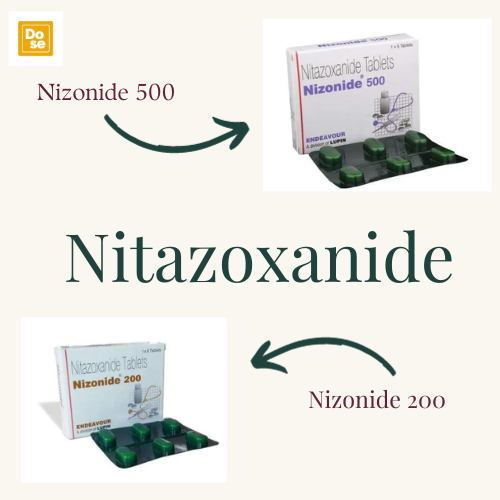
Nitazoxanide 500 mg is a medicine that has gained attention for its broad-spectrum antiparasitic and antiviral effects. Originally developed as a treatment for intestinal parasitic infections, it has since been found effective against a variety of pathogens, including some viruses and bacteria. Despite its wide range of applications, patients and healthcare providers often wonder about the timeline for experiencing relief from symptoms. Understanding how long it takes for nitazoxanide to work is crucial for effective management and treatment planning.
What is Nitazoxanide?
Nitazoxanide is a synthetic nitrothiazole derivative with antiparasitic and antiviral properties. Its primary use has been for treating gastrointestinal infections caused by protozoa and helminths, such as Giardia lamblia, Entamoeba histolytica, and Cryptosporidium parvum. Additionally, nitazoxanide has been found to be effective against certain viral infections, including rotavirus and some strains of influenza. The drug works by disrupting the biochemical processes of pathogens, specifically inhibiting the pyruvate-ferredoxin oxidoreductase (PFOR) enzyme system, which is crucial for their energy metabolism.
Onset of Action for Nitazoxanide
The onset of action for any medication can vary depending on several factors, including the type of infection being treated, the severity of the infection, and the individual’s overall health. Generally, nitazoxanide starts to work relatively quickly, but the exact timeline can differ:
- Gastrointestinal Infections: For gastrointestinal infections caused by protozoa or helminths, patients often begin to notice improvement within 24 to 48 hours of starting the medication. However, complete resolution of symptoms may take a bit longer. Clinical studies suggest that nitazoxanide effectively clears the infection in most cases within a week to ten days of treatment. Symptoms such as diarrhea, abdominal pain, and nausea typically begin to improve as the drug starts to exert its effects.
- Viral Infections: When used for viral infections, such as rotavirus or influenza, the onset of symptom relief can be somewhat variable. Nitazoxanide’s antiviral effects are usually observed within 48 to 72 hours. In some cases, patients might experience an initial worsening of symptoms before significant improvement is noted. For viral infections, the duration of treatment may also be influenced by the specific strain of the virus and the individual’s immune response.
Factors Influencing the Efficacy and Onset of Nitazoxanide
Several factors can influence how quickly nitazoxanide works and its overall efficacy:
- Type of Infection: The nature of the infection plays a significant role. For instance, parasitic infections often show quicker responses compared to some viral infections. Protozoal infections like Giardia and Cryptosporidium generally respond well within a few days, while viral infections might require more time.
- Dosage and Compliance: Adhering to the prescribed dosage and completing the full course of treatment is critical for the effectiveness of nitazoxanide. Inadequate dosing or premature discontinuation of the medication can lead to suboptimal outcomes or recurrence of the infection.
- Individual Health Factors: Patient-specific factors, including age, immune status, and overall health, can affect how quickly nitazoxanide works. For example, individuals with compromised immune systems may experience a delayed response compared to otherwise healthy individuals.
- Severity of Infection: The severity of the infection can also impact the speed at which symptoms improve. More severe infections might take longer to resolve, even with effective treatment.
- Concurrent Medications: Patients taking other medications may experience interactions that can influence the effectiveness of nitazoxanide. It’s important to discuss all medications and supplements with a healthcare provider to avoid potential drug interactions.
Monitoring and Follow-Up
Monitoring the response to nitazoxanide is essential for assessing the effectiveness of treatment. Healthcare providers typically recommend follow-up appointments to ensure that the infection is resolving and to address any potential side effects. If symptoms persist or worsen despite treatment, additional diagnostic testing or a change in therapy may be necessary.
Potential Side Effects
While nitazoxanide is generally well-tolerated, it can cause side effects in some patients. Common side effects include gastrointestinal signs such as nausea, vomiting, and abdominal hurt. These side effects are usually mild and temporary. In rare cases, more severe reactions may occur, and any unusual symptoms should be reported to a healthcare provider promptly.
Conclusion
Nitazoxanide is an effective medication for treating a range of parasitic and viral infections, with the onset of action typically occurring within 24 to 72 hours. The exact time frame for experiencing symptom relief can vary based on the type and severity of the infection, the individual’s health, and adherence to the prescribed treatment regimen. For most patients, nitazoxanide provides noticeable relief within a few days, with full resolution of symptoms often occurring within one to two weeks.
Patients should follow their healthcare provider’s instructions closely and attend follow-up appointments to ensure the effectiveness of the treatment and to manage any potential side effects. Understanding the expected timeline for nitazoxanide’s effectiveness can help in setting realistic expectations and ensuring optimal outcomes in the treatment of infections.










